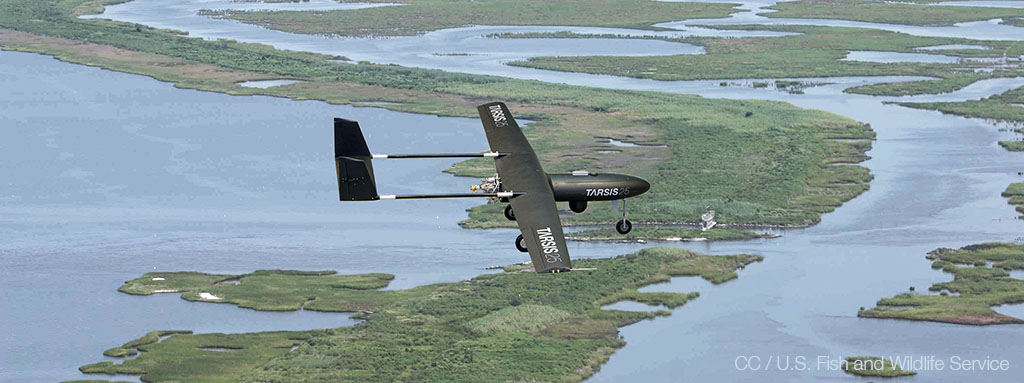Many of us recall the nostalgic image of a light aircraft flying across the sky above the sea dragging an advertising sign behind it, perhaps an indication that summer was coming to an end. Aerial advertising is just one of the many kinds of aerial work that can be done.
RPAs offer greater versatility than piloted aircraft and more specifically in the variety of configurations.
The Royal Decree Law setting forth the conditions for operating Remotely Piloted Aircraft (RPAs) was published in the Official Journal of the State in the middle of 2014. That could have been an opportunity to complement the traditional business of companies that provide aerial work, along with associated advantages like increasing the safety of operations and reducing operating costs. Most of them, however, have kept to their traditional business and the companies providing services with RPAs have been set up by young entrepreneurs. Who better than those who know the business and the clients to transform their business through innovation and start providing services that were previously delivered with aeroplanes and helicopters by using RPAs? Since then, more than 2,400 operators that use RPAs for aerial work — including both companies and individuals – have registered at the AESA (Spanish National Air Safety Agency) to date.
With the clarity given by hindsight, the aerial services market which uses RPAs does not seem to have taken off just when the new regulation on RPAs is about to be published. Some put this down to the constraints stipulated by the regulation, though it is true that the market volume foreseen by most studies does not seem to have materialised, at least in the private sector, despite the fact that some highly specialised small companies provide this kind of services. Furthermore, the public civil sector is not accessible to micro-SMEs due to matters having to do with financial solvency and others. Hence, public investment is for the moment centred on experimental projects to validate the suitability of this kind of aircraft and technology for the provision of services which have traditionally been carried out by manned aircraft.
But what type of aerial work is provided and with what aircraft? Which work can be carried out by RPAs and which seems difficult, at first sight, for RPAs to carry out in the short and medium term?
The aerial work traditionally carried out by piloted aircraft, either fixed-wing aircraft or helicopters, are as follows:
- Aerial photography
- Journalism, television or film shooting flights
- Aerial advertising
- Flights at special events, including flight exhibitions and competitive flying
- Towing gliders
- Parachuting and free-fall operations
- Aerial mapping
Cessna or Piper light aircraft tend to be used for this kind of work.
- Agricultural flights
The best-known crop-spraying aeroplane is the Air Tractor with its characteristic yellow colour.
- Observation and patrolling
- Oil spill work
- Maritime rescue
The maritime patrol version of the CN235 designed by the former Construcciones Aeronáuticas (today integrated into Airbus Defence and Space) and principally AgustaWestland, Eurocopter (Airbus Helicopters) and Sikorsky helicopters are used for this kind of work.
- Helicopter operations involving external loads
- Fire extinction
Both aeroplanes and helicopters are used in fire extinction flights. The Air Tractor in both its land and hydroplane versions, along with the well-known Canadair and Bombardier aircraft with their red and yellow stripes are used in Spain for fire extinction tasks. Vulcanair and Cessna aeroplanes are employed to coordinate fire-extinction assets. The most commonly used fire extinction helicopters used to transport fire-fighting brigades and provide water discharge support are manufactured by Bell, as are Kamov bombers.
Other curious kinds of work performed mainly by helicopters due to their ability to hover above a position are as follows:
- Construction flights, including laying electric power lines, and aerial pruning work
- Operations to provoke avalanches
- Releasing sterile insects for pest control purposes
- Herding, animal rescue flights and veterinary launch flights
The variety of aerial work is far greater that what one would think at first sight and the vast majority of said work could doubtlessly be done with RPAs, including new kinds of aerial work. More than just technology, the principal constraint today has to do with regulation. The main novelty in the new Spanish regulation will allow one to provide services in urban areas, but the main constraint will continue to be the limitation placed on the distance between the aircraft and the remote pilot. This limits the range of operation (in practical terms, it is five hundred metres around the remote command and control station).
RPAs offer greater versatility than piloted aircraft and more specifically in the variety of configurations, which include: fixed-wing, rotary-wing, multirotor and even hybrid configurations that allow all kinds of applications to be performed. However, it is foreseeable that applications involving the lifting of loads – like in fire extinction tasks, for instance – will take decades before they are allowed for safety reasons. In aeronautics, safety goes hand‑in‑hand with an aircraft’s airworthiness certification. The certification process entails significant investments in the design, implementation and testing stages of the aircraft’s different systems. It therefore seems that RPAs technology will have to wait until the regulations are relaxed, and companies will have to demonstrate the safety of flight operations on the basis of their efforts and experimental testing. In the short/medium-term we will only see small RPAs doing filming tasks, mapping work and small scale agricultural jobs. Providing support to fire extinction tasks is another of the services in which these aircraft excel. We hope the outlook changes for the sake of this technology and the aeronautical industry, thereby allowing for the creation of new and interesting business lines for the industry.



